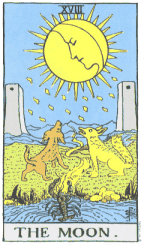USING TAROT WITH DREAMS THAT GOT AWAY

Most of us who remember our dreams have had a dream that when we woke totally evaporated. But for some reason, rather than just letting it go, we find ourselves grasping frustratedly after it. The Tarot layouts below offer three different exercises I've developed to possibly retrieve aspects of just such a runaway dream.
You need not be familiar with The Tarot to use it this way. When working with dreams, your intuitive responses are at least as and maybe more valuable than knowledge of The Tarot.
Before I go on, I'd like to say that I do not necessarily believe that all dreams need to be remembered. But I do believe that when we have that sense of frustration or yearning on not being able to remember a particular dream, it may be useful to try one of these Tarot layouts.
Also you will note I mention the idea of a dream evolving. I believe all dreams -- remembered or not -- are unfinished, that they are all going somewhere, just as our lives are.
If you try any of these layouts don't forget to record the exercise you used, and the cards you got and your responses to them in your dream journal.
Choose one of the options below, and think about it as you shuffle:
(1) What is an important underlying theme of the forgotten dream.
-- OR --
(2) What was an ACTUAL image in the forgotten dream -- this question might trigger some dream recall when you see the Tarot card. (Of course, The Tarot has only so many images, so the pictures on the card you get will most probably need to be looked at in a very general or associative way. However, that said, I have had The Fool, about to walk off that cliff into thin air, trigger a bit of memory of a dream in which I struggled to fly, i.e. to take off.)
Then pull one card, meditate on it with respect to the focus above that you chose, and make notes in your dream journal.
Look through all the cards of your Tarot deck and choose a card that somehow feels like it might relate to the forgotten dream, whether your choice makes sense to you or not, whether you like the card or not.
Then put this card back in your deck and shuffle thoroughly.
With the deck face up in one hand, go looking for the card you chose. When you find it, the card beneath it will be "where the forgotten dream was coming from" and the card above it will be "how the forgotten dream was trying to evolve."
This is a five card layout and is a bit more involved. Shuffle and pull five cards at random. Lay them out face down, right to left (yes, this is the reverse of most horizontal layouts -- you are attempting to work backward in time, in a way), starting with card one. Then explore each card with respect to the following:
Card 1 = Where the dream was coming from.
Card 2 = What the dream was trying to tell you.
Card 3 = How the dream was trying to evolve.
Card 4 = How you can best support that evolution.
Card 5 = What Spirit/High Self was saying through the dream.
Even if you get no particular sense that you've touched on the runaway dream, you may find your responses to the cards that you pull enlightening in some way. In fact, these layouts can be readily modified to address anything you'd normally go to The Tarot with, not just unremembered dreams.
*My thanks to Eva Yaa Asantewaa for the inspiration for exercise #2.
Resource: transcript of Tarot use with a support group led by Dr. Art Rosengarten; a very good example of how to relate to the cards; has a nice layout, too.
Please see the top of the sidebar for my background with the Tarot and a recommendation to beginners.
‘til next time, keep enjoying The Tarot,
Roswila
[aka: Patricia Kelly]
****If you wish to copy or use any of my writing, please email me for permission (under “View my complete profile”)**** SEE ALSO: Roswila’s Dream & Poetry Realm for some articles about Tarot.****



0 Comments:
Post a Comment
<< Home